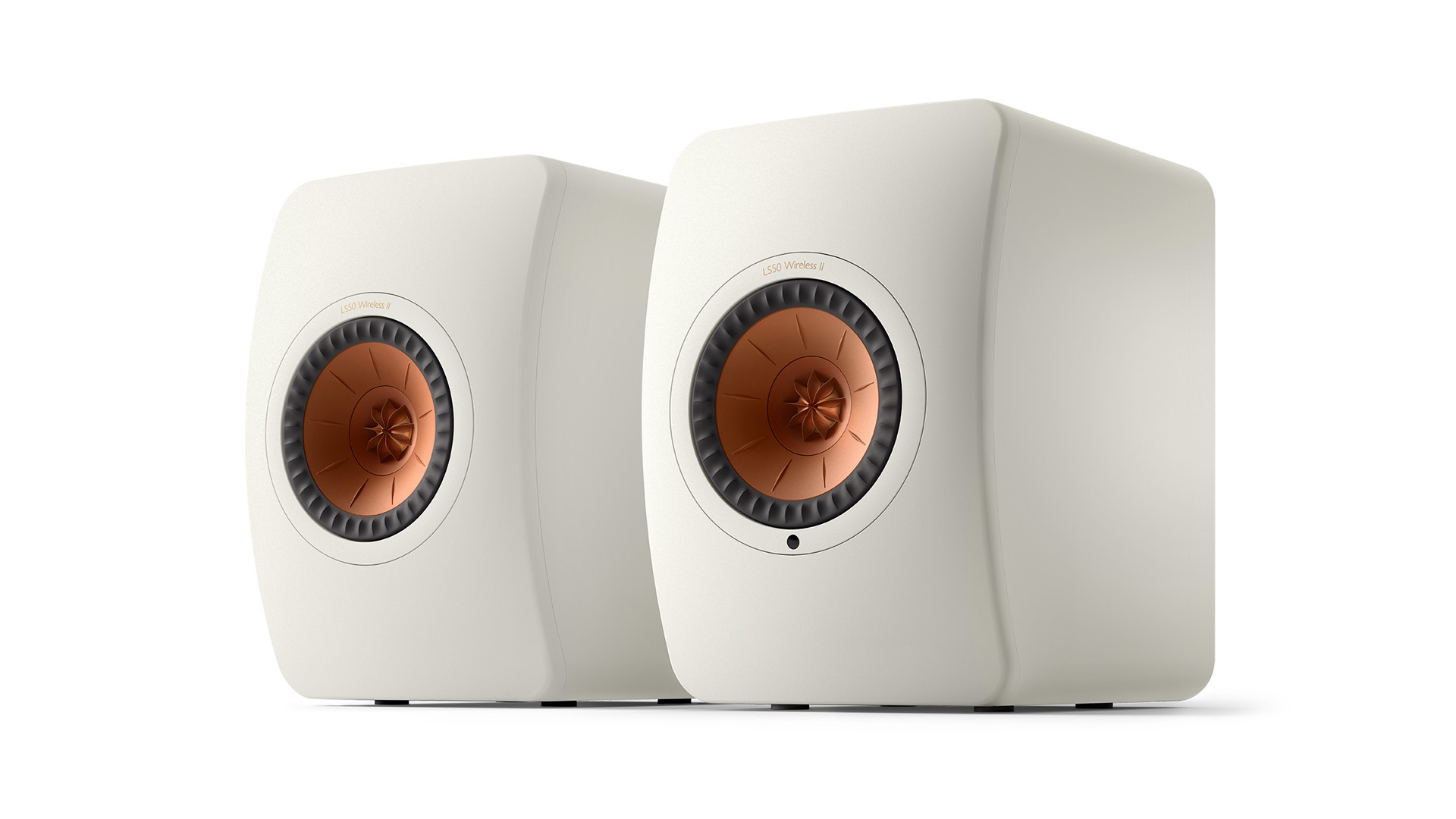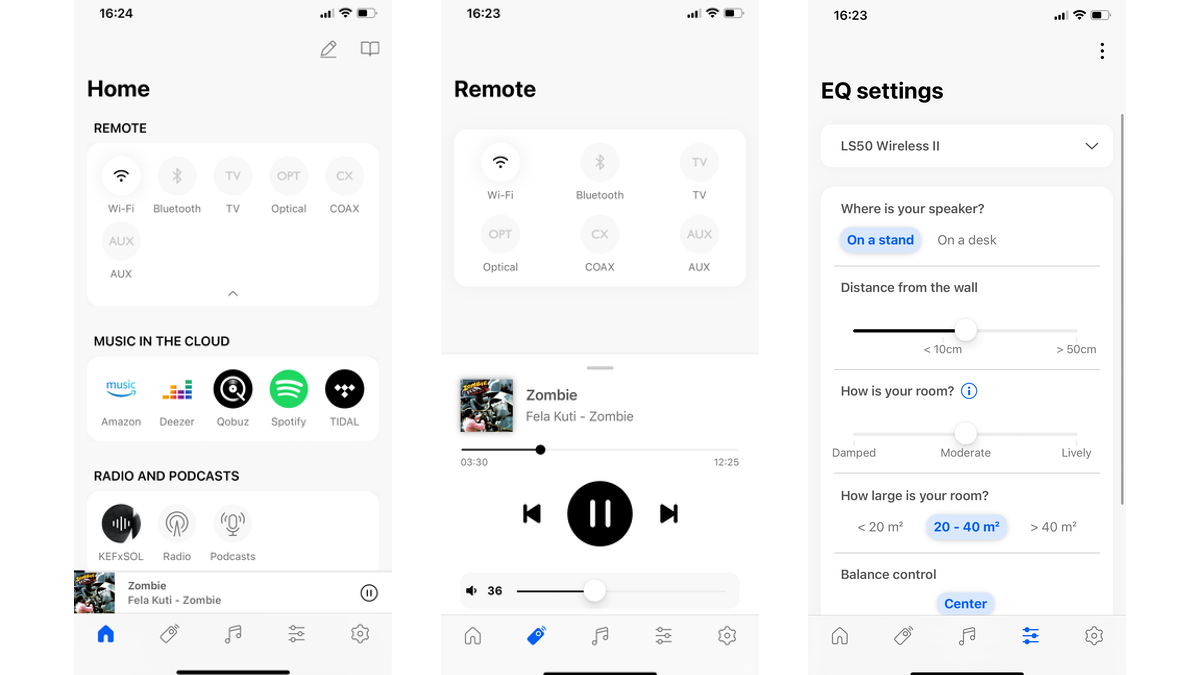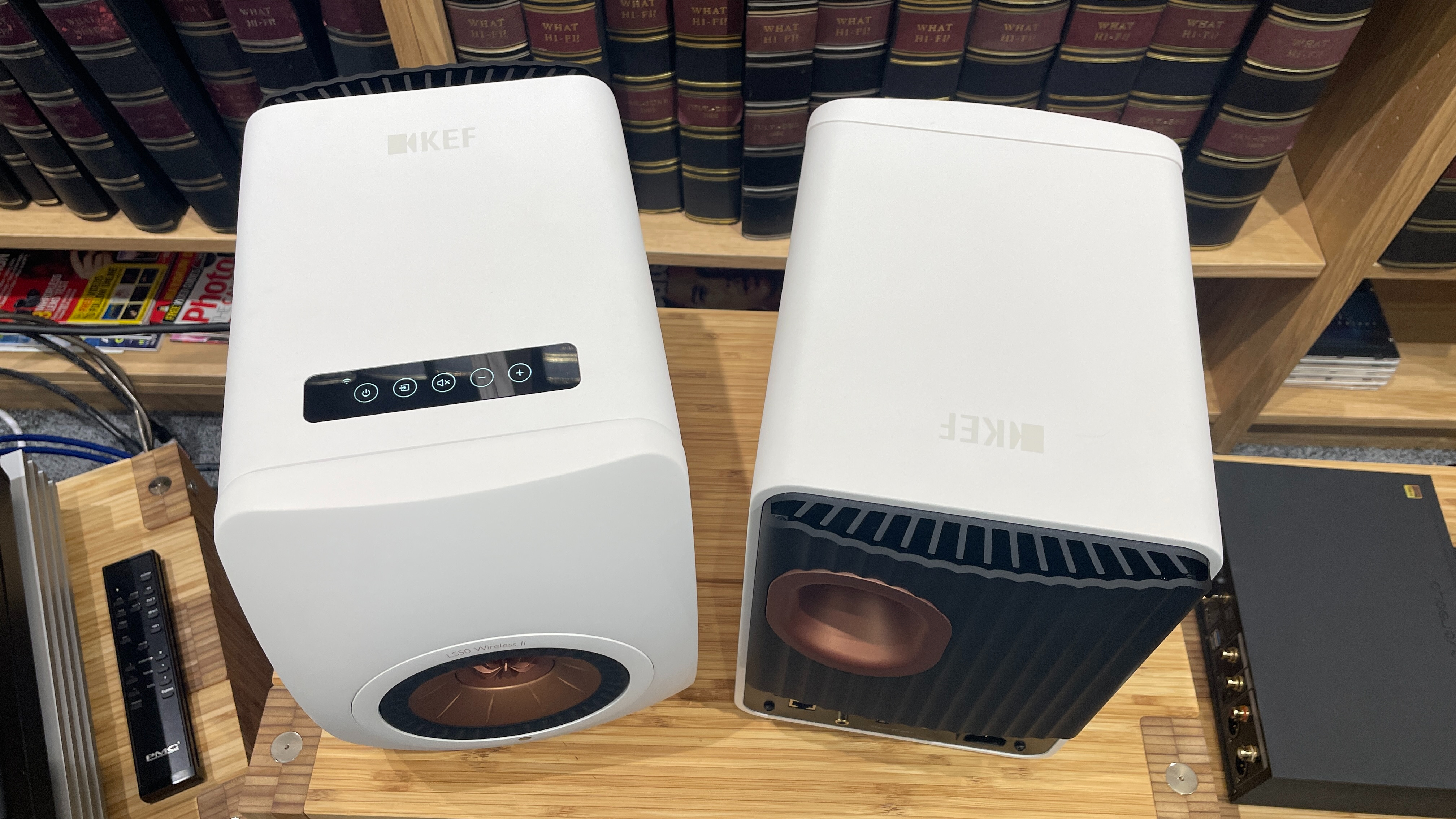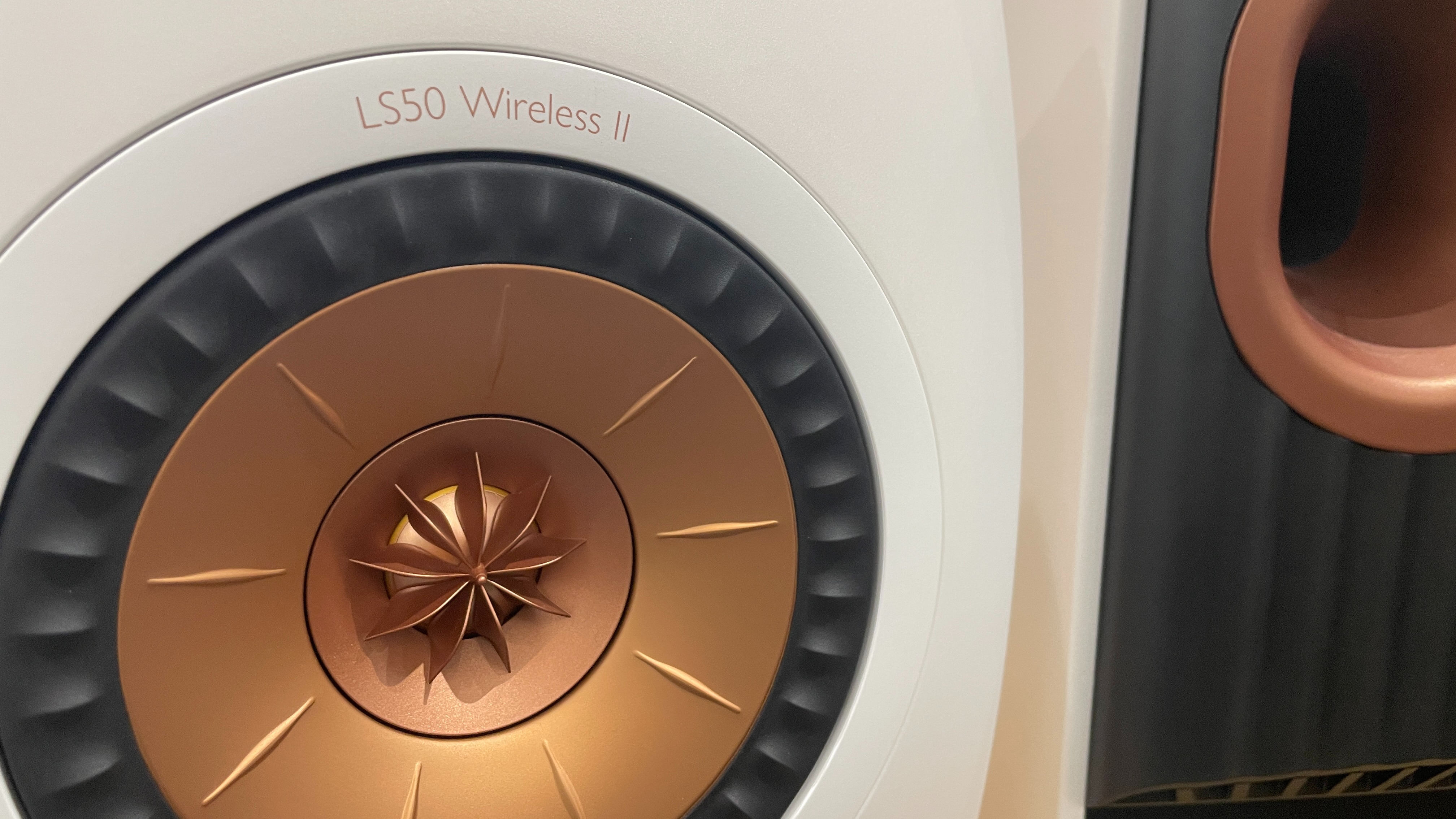What Hi-Fi? Verdict
KEF’s revisions have paid off: these sequels are among the most thrilling speaker systems we’ve heard
Pros
- +
Big performance leap
- +
Clean, punchy sound
- +
All-encompassing connectivity
Cons
- -
Best placed on dedicated stands
- -
Won't suit smaller rooms
Why you can trust What Hi-Fi?
The name of KEF’s latest all-in-one system leaves no doubt as to their heritage. The brand is clearly proud of the fact that the KEF LS50 Wireless II is a sequel to a product that we regarded highly enough to be a What Hi-Fi? Hall of Fame entry – and it has every right to be.
The LS50 Wireless launched in 2016 as an active speaker system take on KEF’s legendary passive LS50 speakers. It's a pair of wireless stereo speakers packed with built-in amplification and streaming smarts, and their impressive execution of this appealing concept earned them a five-star review and a What Hi-Fi? Award.
They weren’t perfect: they came with some control app hiccups, and the need for a cable to connect the two speakers was a small blip in an otherwise neat package. Not only are the new KEF LS50 Wireless II speakers untethered, but they also come with a new and improved app.
The LS50 Wireless II doesn’t simply address its predecessor’s imperfections, though. They have been designed to squeeze even more performance out of the familiar chassis and Uni-Q driver arrangement through the introduction of a new KEF innovation called Metamaterial Absorption Technology (MAT).
Essentially, MAT is a clever way of absorbing sound waves that radiate from the rear of the tweeter dome so that they don’t distort the unit’s forward output. Physically, this technique sees a round piece of plastic with a maze-like structure placed behind the tweeter.
Each ‘path’ in the structure is a certain size and length and ‘tuned’ to absorb a specific range of frequencies. KEF says that, together, the various paths effectively act as an ‘acoustic black hole’, absorbing 99 per cent of the unwanted sound.
This absorption technique has been used in other fields before, but this joint initiative with smart materials and acoustics company Acoustic Metamaterials Group marks its first application in a loudspeaker. It has also been implemented in KEF's more recent passive speakers, such as the LS50 Meta, R3 Meta and R1 Reference Meta. It is featured in the floorstanding LS60 Wireless speaker system, but is omitted from the smaller LSX II and LSX II LT models in the KEF LS wireless speaker systems range.
The latest hi-fi, home cinema and tech news, reviews, buying advice and deals, direct to your inbox.
Features

The 12th generation of KEF’s patented Uni-Q is not only defined by MAT but also a reworked motor system, for which KEF has optimised its bespoke digital signal processing algorithm system. Mirroring the LS50 Wirelesses’ configuration, a new 100W class A/B amplifier powers the tweeter, while 280W of power is available to the mid/bass driver.
In 2018, when KEF introduced its LSX speaker system – essentially a miniature version of the LS50 Wireless – it replaced the physical inter-speaker cable with a wireless connection that could play files (up to 24-bit/192kHz) across a maximum 24-bit/48kHz resolution.

Driver Uni-Q driver array (25mm aluminium tweeter; 13cm aluminium mid/bass)
Max power 380W per channel
Streaming AirPlay 2, Google Chromecast, UPnP, Bluetooth 5.0, Roon Ready
Streaming services Spotify Connect, Tidal Connect, Amazon Music, Qobuz, Deezer
Max resolution support 24-bit/384kHz, DSD256, MQA
Inputs HDMI eARC, coaxial, optical, 3.5mm aux, Ethernet
Output Subwoofer x2
Dimensions (hwd) 30.5 x 20 x 31.1cm
Weight: 20.1kg
Finishes x4 (carbon black, titanium grey, mineral white, crimson red special edition)
It’s no surprise to see this more convenient method used in the LS50 Wireless II, although the wireless limit has been upped to 24-bit/96kHz, meaning they only need to downsample files above that resolution – peak file support is 24-bit/384kHz. Physically connecting the right (master) and left (slave) speakers via the included ethernet cable increases native playback to 24-bit/192kHz.
Support for DSD256 is also onboard this time, too, as is MQA decoding for the playback of compatible downloaded files and hi-res Tidal Masters.
Tidal is one of many streaming services directly accessible from the new KEF Connect app – you have Amazon Music, Qobuz, Deezer and Spotify, as well as internet radio and UPnP servers, at your fingertips too.
During our original review, we only had access to an early version of the app, so some functionality – including music server discovery – wasn't available. However, we've since tested the full-fledged app and it's a positive replacement for the often-glitchy Stream app on the LS50 Wireless. Loading dense service libraries, navigating its clean and logical interface and switching inputs proves a pleasant and reliable experience.

You could own these KEFs and have little need for the dedicated app, considering the LS50 Wireless II support AirPlay 2, Google Chromecast and Bluetooth, and are also Roon Ready.
Despite ditching the USB Type-B computer connection, KEF has hardly shortchanged future owners in terms of connectivity, replacing it with an HDMI eARC socket to make it more TV-friendly. Alongside it are coaxial (24-bit/192kHz), optical (24-bit/96kHz) and 3.5mm aux inputs and a subwoofer output – which round off the LS50 Wireless II's comprehensive spec sheet.
Build

The considerable advancements KEF has made for this sequel are belied a little by the familiar aesthetic. In fact, you would perhaps need to look at the underside of the new LS50 to tell them apart from their predecessor. They have threaded inserts in each corner, allowing them to lock onto the top of the new KEF S2 Floor Stands (£400, $449, AU$800 per pair).
However, considering the design is based on the passive LS50, one of the most recognisable and striking loudspeakers around, that familiarity is no bad thing. The contrasting Uni-Q driver array, beautiful Carbon Black, Titanium Grey, Mineral White and Crimson Red Special Edition finishes, and curved front panel all combine to create a thorough head turner.
While conceptually similar stereo speaker systems have come into the market since the LS50 Wireless’s arrival, none we’ve seen are neater than this next-generation version.
Sound

In our review of the original LS50 Wireless, we noted their “clean and precise” manner and “neatly layered and nicely defined” soundstage. KEF has taken these attributes to another level here.
The effect of MAT is clearly heard in the cleanliness of the treble, although the difference in purity can be heard across the frequency range. Mids are cleaner-cut and bass more defined, their extra refinement making the originals sound a touch crude. The whole presentation has been opened out, that extra room not only filled with subtler, more precise detail, but also allowing for greater instrument separation that makes its delivery sound much less congested in comparison.
We listen to Adrienne Lenker's Symbol and it is a more captivating affair through the Wireless IIs. The extra space between her vocal and the strings is in relative contrast to the originals, where it sounds as though they're fighting against one another for attention. That extra spaciousness isn’t at the expense of cohesiveness either – a hallmark quality of the Uni-Q driver’s tweeter-inside-the-mid/bass-cone design.
The new KEFs lay bare more intricacies in the guitar work, while disclosing the distinctive fragilities in her vocal. Similar sharpness and attention to detail is evident as we switch to Peter Broderick's Moment, the piano sequence aching with meticulously written melody as the LS50 Wireless II more deftly define the start and finish of notes.
We play Mac Miller's What's The Use? and the Wireless II are keen to show off their improved punch and agility as well as their enhanced subtlety. Their clarity and cleanliness enlivens the tuneful bassline and unequivocally cutting rap, complementing the track’s clinical production.
Verdict

These sonic advancements are not only a credit to KEF's engineering but also representative of how far such speaker system concepts have come in recent years. Needless to say, we look forward to hearing more products using MAT technology in the future.
Upon their launch in 2016, KEF’s LS50 Wireless highlighted the appeal of an all-in-one stereo system over a system of separates at the modest end of the market, and the LS50 Wireless II simply improve on that concept.
As a product following in the footsteps of such a huge success, the KEF LS50 Wireless II system arrives with a world of expectation on its shoulders – but it well and truly meets those expectations. Make no mistake, this is a sequel of rare quality.
Review published: 2020. Review updated: November 2024.
SCORES
- Sound 5
- Features 5
- Build 5
MORE:
KEF wireless speaker systems compared, from LSX II to LS60 – which one should you buy?
Check our the best hi-fi systems around
Read our KEF LS50 Meta review
And our KEF LSX II review
What Hi-Fi?, founded in 1976, is the world's leading independent guide to buying and owning hi-fi and home entertainment products. Our comprehensive tests help you buy the very best for your money, with our advice sections giving you step-by-step information on how to get even more from your music and movies. Everything is tested by our dedicated team of in-house reviewers in our custom-built test rooms in London, Reading and Bath. Our coveted five-star rating and Awards are recognised all over the world as the ultimate seal of approval, so you can buy with absolute confidence.
You must confirm your public display name before commenting
Please logout and then login again, you will then be prompted to enter your display name.



